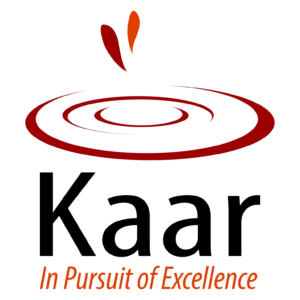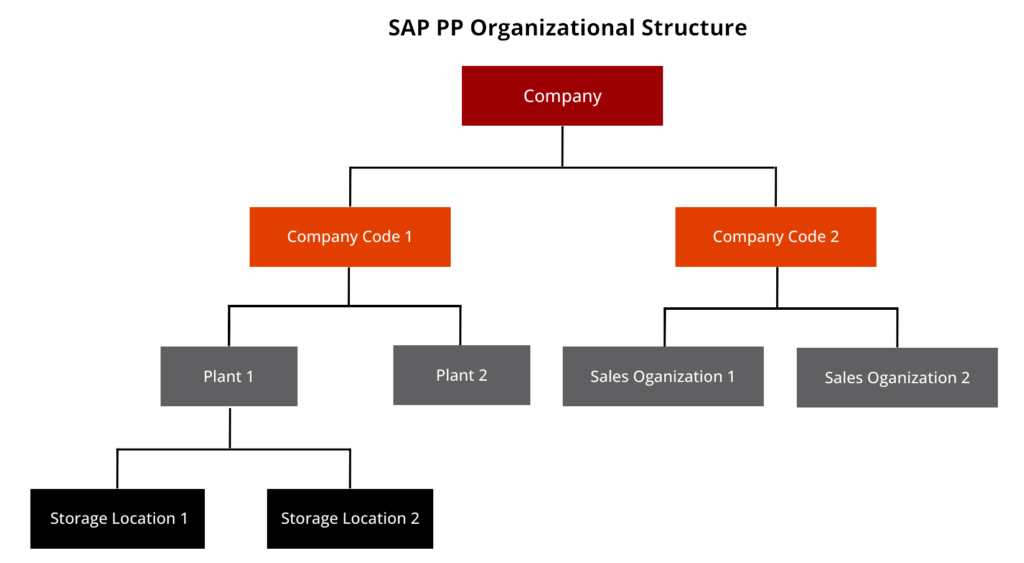Have you ever thought about how the products you use every day are made? Just like you plan and organize your day, businesses need a plan too. That’s where SAP Production Planning (SAP PP) comes into play. It’s like a well-thought-out to-do list for manufacturing.
In this blog, we’ll explore SAP PP in everyday terms, from how it’s organized to how it manages the production process. Get ready to uncover the SAP PP Organizational Structure that keeps the wheels of manufacturing turning smoothly.
What is SAP PP?
SAP Production Planning (SAP PP) is an essential component of ERP Central Component (ECC) that aids in managing the planning, production, and distribution of goods. It integrates with various ECC functions and includes activities like material requirements planning, bill of materials management, routing, and capacity planning.
SAP PP relies on centralized master data, such as material details, work center information, and BOM specifications. It supports different manufacturing industry types, including discrete, repetitive, and process manufacturing, with each having unique characteristics.
Now that we have explored SAP PP in detail, let’s shift our focus to the concept of production planning.
What is Production Planning?
Production planning is a systematic approach that harmonizes demand with manufacturing resources through the creation of production and supply strategies for finished products and components.
The SAP production planning module holds significant importance as it not only monitors and documents anticipated and actual manufacturing expenses but also seamlessly integrates with various other SAP modules including SD, MM, QM, FICO, and PM.
SAP PP Organizational Structure
- Company Code:
The smallest unit within a company under the client’s level, maintaining independent accounting records.
- Plant:
Business unit responsible for production and goods provision, housing manufacturing facilities and warehouses.
- Storage Location:
Units within an organization dedicated to material stock storage, with multiple locations within a plant.
Sub-modules of SAP Production Planning (PP)
In this SAP PP guide, we explore two distinct production industries within the SAP PP module:
- Discrete Production:
In this industry, material production varies based on specific orders, with costs calculated accordingly.
- Repetitive Production:
This industry maintains consistent production materials over an extended period, producing items based on total quantity rather than individual orders.
Integration of SAP PP with Other Modules
Explore the integration of SAP PP with different SAP modules for seamless production planning:
- SAP MM and SAP PP:
➔ Automated goods receipt and movement of goods.
➔ Creation of planning/booking for production orders.
➔ Purchase order generation through MRP runs.
- SAP SD and SAP PP:
➔ Updates the organization on material availability.
➔ Manages requirement types and MRP runs.
➔ Controls the process and cost of material components.
- SAP FICO and SAP PP:
➔ Maintains price updates in Material Master Data.
➔ Defines activities for cost center entry.
➔ Assigns activity types to work centers.
➔ Executes cost estimation and controls the Cost of Production.
- SAP Task System and SAP PP:
➔ Assigns planning activities to WBS in projects.
➔ Runs Material Requirement Planning at the project level.
➔ Connects components to the network reserved as plant stock.
- SAP Quality Monitoring and SAP PP:
➔ Inspects Type 03 for repetitive and discrete manufacturing.
➔ Inspects Type 04 for both repetitive and discrete manufacturing.
Let’s delve into the hierarchical organization of SAP Production Planning, encompassing various levels and units:
Master Data in SAP PP
Master data in SAP PP comprises information that remains relatively unaltered within an enterprise. In SAP’s production planning module, five primary master data categories are essential for effective operations:
- Material Master:
This database holds details about all materials a company procures, manufactures, processes, and distributes. It is used for various purposes, including purchasing materials, inventory management, sales and distribution, and production procedures.
- Bill of Material (BOM):
A BOM is a structured list of components and quantities required for product assembly. It aids in planning and costing material specifications, allowing for flexibility with variant products.
- Work Centre:
Work centers are systems or groups of machines where manufacturing processes take place. They provide critical information for scheduling, capacity, and costing.
- Product version:
A product version is an older product that has been updated with new features. The product version is created in response to shifting consumer trends and market need. It is created with the bill of products and route data.
- Routing:
Routings define a series of operations to be performed at a work center, specifying system and work times for each operation.
Production Planning Cycle
The production planning cycle is divided into two core phases:
- Planning –
Typically, the planning process begins with the establishment of a budgeted revenue schedule. This planning aligns with the production cycle periods and relies on the sales schedule to meet customer demands. It encompasses anticipated independent needs, which are input through demand management. This data forms the foundation for the preparation of material requirements.
By utilizing master data such as the Bill of Materials (BOM) and available plant stocks, Material Requirements Planning (MRP) evaluates the availability of various raw materials needed for manufacturing at different intervals.
In cases of material shortages, procurement specifications are generated for externally procured products, and planned orders are created for in-house production. These actions kick-start the procurement and production processes. As MRP operates with unlimited capacity, capacity leveling is essential to prevent any potential capacity constraints.
- Execution –
The conversion of planned orders into production orders is a key step in the execution phase. These production orders are meticulously scheduled according to the designated production timelines, using essential master data like routings. The issuance of production orders takes place on the shop floor under the supervision of the Production Supervisor.
During this phase, thorough checks on material availability are conducted to ensure all necessary components are on hand. The actual production process is driven by routing activities, where master data linked to each routing operation, particularly at the Work Center, guides the production process.
Upon the completion of the product, order confirmations are processed, marking the materials as used and goods as received against the order. Subsequently, the order is assigned the “Delivered” (DLV) status, and the final products are stored in the desired location for further distribution or use.
Demand Management
Demand management in SAP production planning plays a crucial role in forecasting demand and distribution dates for finished goods and essential assemblies. It distinguishes between two methods: “Make to Stock” and “Make to Order,” tailoring production based on specific orders or stock levels.
- Make to Stock (MTS):
This approach involves producing goods without specific customer orders, with the aim of storing them for future demand. In other words, products are manufactured in anticipation of potential sales rather than being driven by immediate orders.
- Make to Order (MTO):
In contrast, this method pertains to manufacturing products or materials in direct response to a specific customer order or a particular project’s requirements. Production is triggered by the receipt of an order or a predefined customer need, ensuring that items are tailored to specific requests.
Material Requirement Planning (MRP)
MRP detects material shortages and triggers the generation of necessary procurement elements. It calculates the net requirements, resulting in the creation of planned orders for items manufactured in-house and the initiation of procurement for raw materials. MRP also considers lead times, generating planned orders to meet production timelines. It systematically breaks down the Bill of Materials (BOM) and proposes procurement actions at each BOM level to ensure materials are readily available.
Capacity Planning and Balancing
Within the SAP production planning process, capacity planning plays a vital role in evaluating work center capacities to prevent potential bottlenecks and overloads. Material Requirements Planning (MRP) generates capacity requirements for work centers, but it operates under the assumption of unlimited capacity, disregarding constraints. Therefore, the need arises to balance and optimize work capabilities.
This optimization is achieved through a planning table, which helps in creating a controlled production schedule, ensuring that each work center’s capacity is efficiently utilized and levelled to avoid operational constraints.
Production Orders
After the Material Requirements Planning (MRP) generates “planned orders,” the next step is to transform them into “production orders” for further execution. These production orders serve as distinct and independent records, not directly influenced by the MRP process.
Each production order specifies the materials required and their quantities for production. It also encompasses the components listed in the Bill of Materials (BOM) and outlines the specific routing procedures to be carried out at the designated work center. These orders are then released for execution, and checks are performed to ensure all necessary components are available before production begins.
Production Order Confirmation
During the physical assembly of products on the factory floor, production orders must be verified. Confirmation can be automatic, with components consumed through back-flushing, and products collected using a Control Key. However, manual handling of product issues and receipts can be done separately if automatic processes are not suitable.
In case of component shortages, manual adjustments can be made. Activity costs, including equipment and labour, are updated based on actual data during order validation. Once all processes are complete, the order receives a “Confirmed” (CNF) and “Delivered” (DLV) status. If there are errors in the confirmation, corrections can be made by cancelling and re-posting with the accurate data.
Production Order Closure
When it comes to wrapping up a production order, there are two scenarios. First, the order is marked as technically complete, indicating that it has been fulfilled. Second, if there’s a decision to no longer proceed with fulfilling the order, it is closed. In either case, once the order is given the status of “TECO” (Technically Completed), it is removed from the list of stock or material requirements, ensuring it is no longer considered for future planning. Furthermore, all associated reservations are systematically deleted from the system.
Conclusion
In conclusion, SAP Production Planning (SAP PP) simplifies and enhances manufacturing processes, and its relevance extends to various industries. As technology advances, acquiring skills is essential for staying competitive. This transition is particularly evident in the accounting sector, where SAP has replaced traditional coding software.
With SAP’s global growth, the demand for professionals in Indian industries is increasing. The shift from offline to online processes continues to drive the popularity of SAP PP. Our team of experts is here to guide you, providing the support you need for a successful journey in the world of SAP PP.
For further inquiries or guidance, please feel free to contact us.
FAQ’s
What is SAP PP and its role in manufacturing?
SAP PP is an integral component of ERP Central Component (ECC) that manages planning, production, and distribution in manufacturing. It integrates with various functions, including material requirements planning, bill of materials management, routing, and capacity planning.
Explain the SAP PP organizational structure.
In SAP PP, the organizational structure emphasizes the importance of plant and storage locations. These locations are crucial for managing master production data, executing planning activities, coordinating production confirmation, and handling goods movement.
How does Material Requirement Planning work in SAP PP?
Material Requirement Planning (MRP) in SAP PP detects material shortages, triggers the generation of procurement elements, and creates planned orders for in-house production. It considers lead times and systematically breaks down the Bill of Materials (BOM) to ensure materials are available.
What is the production planning cycle in SAP PP?
The production planning cycle in SAP PP consists of two phases: Planning and Execution. During Planning, budgeted revenue schedules align with sales schedules, and Material Requirements Planning (MRP). In the Execution phase, planned orders become production orders, and production is scheduled, confirmed, and checked for material availability.
One Comment
Comments are closed.



Usually I do not read article on blogs however I would like to say that this writeup very compelled me to take a look at and do it Your writing style has been amazed me Thank you very nice article